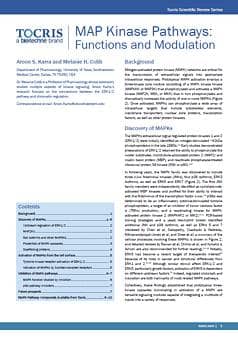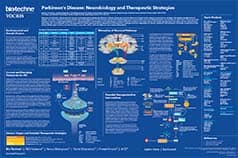Ferroptosis
Ferroptosis is a form of regulated cell death, distinct from apoptosis, necroptosis and autophagy. It is an iron-dependent process that results from the loss of glutathione peroxidase 4 (GPX4) activity, leading to accumulation of lipid peroxidation products and reactive oxygen species (ROS).
Ferroptosis Inhibitors |
|
|---|---|
| Cat. No. | Product Name / Activity |
| 0970 | Cycloheximide |
| Inhibitor of ferroptosis; inhbits protein synthesis | |
| 5245 | Ebselen |
| Inhibitor of ferroptosis; glutathione peroxidase mimic | |
| 5180 | Ferrostatin 1 |
| Selective inhibitor of erastin induced ferroptosis | |
| 6113 | Liproxstatin-1 hydrochloride |
| Potent ferroptosis inhibitor | |
| 2850 | PD 146176 |
| Inhibits ferroptosis; selective 15-lipoxygenase inhibitor | |
| 6002 | Trolox |
| Inhibitor of ferroptosis; antioxidant | |
| 3308 | Zileuton |
| Inhibits ferroptosis; 5-LOX inhibitor | |
Ferroptosis Activators |
|
| Cat. No. | Product Name / Activity |
| 5449 | Erastin |
| Ferroptosis activator; also mitochondrial VDAC modulator | |
| 6280 | FIN 56 |
| Ferroptosis activator | |
| 7941 | FSEN 1 New |
| Induces ferroptosis; inhibits FSP1 | |
| 0218 | L-Glutamic acid |
| Induces ferroptosis; endogenous, non-selective agonist | |
| 7162 | iFSP1 |
| Ferroptosis inducer; inhibits ferroptosis suppressor protein 1 (FSP1) | |
| 6954 | L-Buthionine sulfoximine |
| Induces ferroptosis by inhibiting glutathione synthesis | |
| 7821 | ML 162 |
| Induces ferroptosis; inhibits glutathione peroxidase 4 (GPX4) | |
| 6429 | ML 210 |
| Induces ferroptosis in tumor initiation cells; glutathione peroxidase inhibitor | |
| 6118 | 1S,3R-RSL3 |
| Induces ferroptosis; inhibits glutathione peroxidase 4 (GPX4) | |
| 1965 | Simvastatin |
| Induces ferroptosis; AMPK activator; also HMG-CoA reductase inhibitor | |
| 6814 | Sorafenib |
| Induces ferroptosis; also Raf-1, VEGFR-2, VEGFR-3, PDGFR-β, Flt-3 and cKIT inhibitor | |
| 4935 | Sulfasalazine |
| Ferroptosis inducer; cystine-glutamate antiporter inhibitor and inhibitor of NF-κB activation | |
Controls |
|
| Cat. No. | Product Name / Activity |
| 6687 | 1R,3R-RSL3 |
| Negative control for 1S,3R-RSL3 (Cat. No. 6118) | |
Ferroptosis is a form of regulated cell death, distinct from apoptosis, necroptosis and autophagy. It is an iron-dependent process that results from the loss of glutathione peroxidase 4 (GPX4) activity, leading to accumulation of lipid peroxidation products and reactive oxygen species (ROS).
GPX4 is a selenoprotein that reduces hydrogen peroxide and lipid peroxides, while converting reduced glutathione (GSH) to its oxidized form; oxidized glutathione (glutathione disulfide) is recycled by glutathione reductase and NADPH/H+. Depletion of GSH leads to the inactivation of GPX4 with the resultant accumulation of ROS from lipid peroxidation and subsequent ferroptosis. GPX4 inactivation also causes depletion of arachidonic acid and polyunsaturated fatty acids and this also promotes ferroptosis.
Molecular Pathways of Ferroptosis Regulation

Figure 1: Molecular Pathways of Ferroptosis Regulation. DMT1, Divalent metal transporter 1; Glu, Glutamate; GPX4, Glutathione peroxidase 4; GSH, Glutathione; HMG-CoA, 3-hydroxy-3-methyl-glutaryl-CoA reductase; IPP, Isopentenyl pyrophosphate; ROS, Reactive oxygen species; Se, Selenocysteine; System xc-, glutamate/cystine antiporter; TFR1, membrane protein transferrin receptor 1.
Adapted from Yang and Stockwell (2016) Trends Cell Biol. 26 165.
The mevalonate pathway is an important regulator of ferroptosis, as the synthesis of selenoproteins, such as GPX4, is dependent on isopentenyl pyrophosphate, a product of the mevalonate pathway. Isopentenyl pyrophosphate acts as a donor in the incorporation of selenocysteine into selenoproteins by the enzyme tRNA isopentenyl transferase. The glutamate/cysteine antiporter (system Xc-) is also an important regulator of ferroptosis. Inhibition of this transporter, by increased extracellular glutamate for example, depletes the intracellular pool of cysteine, which is a precursor of glutathione synthesis. This in turn depletes glutathione leading to inhibition of GPX4. The MAPK pathway may also have role in ferroptosis regulation.
While iron is a requirement for ferroptosis, its role in the process is not fully understood. It has been proposed that iron-containing enzymes associated with lipid redox regulation are activated during ferroptosis. Excessive iron contributes to ferroptosis, while iron chelators inhibit Erastin-induced ferroptosis.
Ferroptotic cells appear rounded, with no rupture of cell membranes. Mitochondria are smaller than normal, have dense mitochondrial membranes and lack cristae, while the nucleus appears normal. Ferroptosis is involved in many physiological and pathological processes including cancer cell death, neurotoxicity, neurodegenerative disease, acute kidney disease and T-cell immunity, among others. Inhibition of ferroptosis therefore offers a potential therapeutic approach for a variety of conditions.
Literature for Ferroptosis
Tocris offers the following scientific literature for Ferroptosis to showcase our products. We invite you to request* your copy today!
*Please note that Tocris will only send literature to established scientific business / institute addresses.
MAPK Signaling Scientific Review
MAP kinase signaling is integral to the regulation of numerous cellular processes such as proliferation and differentiation, and as a result is an important focus of cancer and immunology research. Updated for 2016, this review discusses the regulation of the MAPK pathway and properties of MAPK cascades. Compounds available from Tocris are listed.
Parkinson's Disease Poster
Parkinson's disease (PD) causes chronic disability and is the second most common neurodegenerative condition. This poster outlines the neurobiology of the disease, as well as highlighting current therapeutic treatments for symptomatic PD, and emerging therapeutic strategies to delay PD onset and progression.



